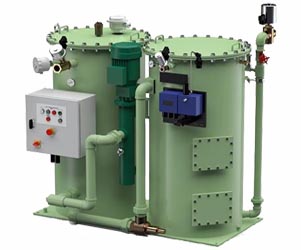
Welcome to Leader in Water- & Wastewater Solution
Welcome to Leader in Water- & Wastewater Solution
An oil-water separator separates gross amounts of oil , suspended solids and emulsified oil from the wastewater effluents of oil refineries, petrochemical plants, chemical plants, natural gas processing plants and other industrial sources.
API and CPI (Corrugated plate interceptor) or TPI (Tilted plate interceptor) separators are predominantly used in separation of free oil from effluent water or suspended solids for oily water treatment in an OWS (oily Water System).
The API separator is a gravity separation device designed by using Stokes Law to define the rise velocity of oil droplets based on their density and size. The design of the separator is based on the specific gravity difference between the oil and the wastewater because that difference is much smaller than the specific gravity difference between the suspended solids and water. Based on that design criterion, most of the suspended solids will settle to the bottom of the separator as a sediment layer, the oil will rise to top of the separator, and the wastewater will be the middle layer between the oil on top and the solids on the bottom.
Typically, the oil layer is skimmed off and subsequently re-processed or disposed of, and the bottom sediment layer is removed by a chain and flight scraper (or similar device) and a sludge pump. The water layer is sent to further treatment consisting usually of a dissolved air flotation (DAF) unit for further removal of any residual oil and then to some type of biological treatment unit for removal of undesirable dissolved chemical compounds.
Parallel plate separators are similar to API separators but they include tilted parallel plate assemblies (also known as parallel packs). The underside of each parallel plate provides more surface for suspended oil droplets to coalesce into larger globules. Any sediment slides down the topside of each parallel plate. Such separators still depend upon the specific gravity between the suspended oil and the water. However, the parallel plates enhance the degree of oil-water separation. The result is that a parallel plate separator requires significantly less space than a conventional API separator to achieve the same degree of separation.

Induced Gas Flotation (IGF) is a water treatment process that clarifies wastewaters (or other waters) by the removal of suspended matter such as oil or solids. The removal is achieved by injecting gas bubbles into the water or wastewater in a flotation tank or basin. The small bubbles adhere to the suspended matter causing the suspended matter to float to the surface of the water where it may then be removed by a skimming device.
Induced Gas Flotation is very widely used in treating the industrial wastewater effluents from oil refineries, petrochemical and chemical plants, natural gas processing plants and similar industrial facilities. A very similar process known as dissolved air flotation is also used for waste water treatment. Froth flotation is commonly used in the processing of mineral ores.
IGF Units in the oil industry do not use air as the flotation medium due to the explosion risk. These IGF Units use nitrogen gas to create the bubbles. The system comes as a complete package, skid mounted with all necessary accessories and controls and proving the following benefits :
• Easy to install and easy to handle
• Exceptionally high purity levels in the effluent water
• Pre-engineered, pre-fabricated structures
• Unit is easily transported to the customer’s project site
• Oily water separators for offshore application
• De-oilers and grease extractors for condensate
• Continuous automatic effluent control to protect absorber and to minimize consumables